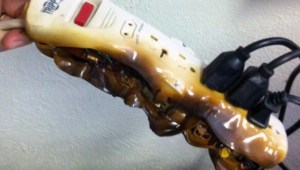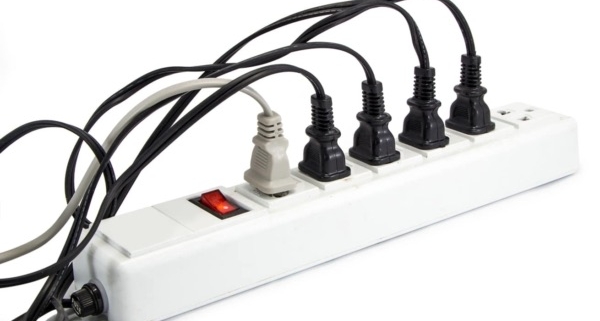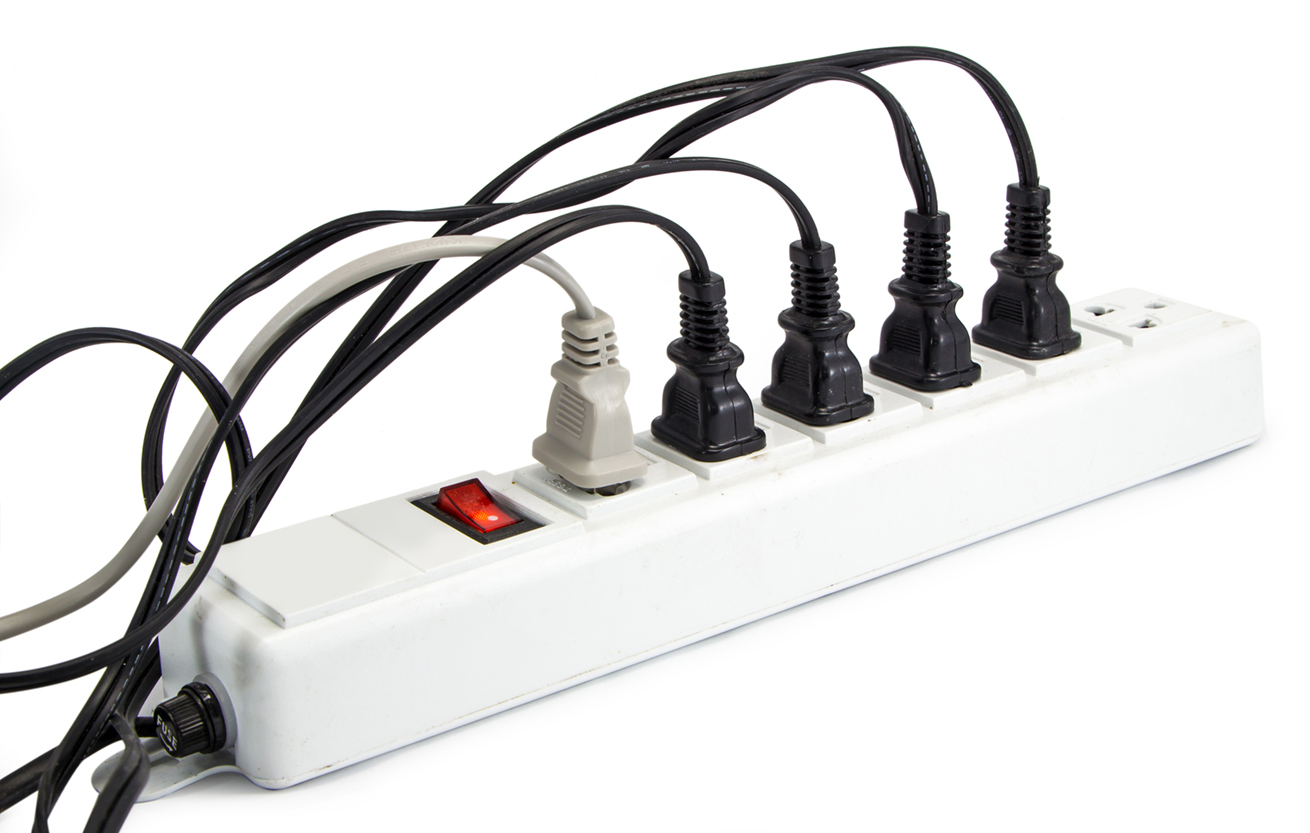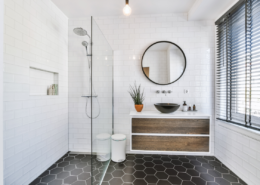11 Things You Should Never Plug Into a Power Strip
Whether you live in a house, apartment, condo, mobile home, RV, or dorm room, having sufficient electrical outlets to handle all the accessories, appliances, and tools you need can be challenging. And that’s when knowing how to use a power strip device safely sure comes in handy.
While one of these devices can offer a reasonable solution for too few outlets, it’s a mistake to rely on power strips too much. Or to use one incorrectly. For safety’s sake, never plug the following items into a power strip.
Hair styling appliances
You need ’em hot and ready to go, which makes a power strip on the bathroom counter pretty much a godsend when you have only that one outlet.
Here’s the problem with that: Hairdryers, curling wands, and flat irons are required to produce heat, which means they pull large amounts of amperage to get them good and hot. Plugging them into a power strip is just asking for trouble.
These types of hair styling appliances must be plugged directly into a wall outlet—preferably one with a GFCI breaker—to avoid bursting that power strip into flames and or accidentally exposing to water.
Refrigerators, freezers
These appliances pull too much current for a power strip because they are continuously cycling on and off. That will quickly overload a power strip. These items need to be plugged directly into a wall outlet that is dedicated to that single appliance. If you plug other appliances into that same (duplex) outlet, you run the risk of tripping a breaker. But you won’t be burning the house down.
Coffee makers
Seems pretty lightweight to heat up water, right? Not so fast. Most coffee makers need a good deal of amperage to turn gloriously roasted coffee beans into a hot beverage — more than a power strip can guarantee to deliver. Make sure you plug the machine directly into a wall outlet.
If you need a good power strip with a circuit breaker and surge protector, this is highly recommended. Just use it wisely!
Toasters
Here’s the clue: It has exposed wires inside those slots that heat up red hot. It takes a lot of current to fire up that heating element, which can easily overload a power strip. So no. Do not plug your toaster into an extension cord or power strip. Ditto for your toaster oven.
Slow cookers
I agree that this is counterintuitive because wouldn’t you think a slow cooker uses microscopic bits of power? In this case, it’s not the amount of amperage but the length of time requiring continuous power. A power strip cannot guarantee to deliver that kind of energy. Plug the slow cooker safely into a wall outlet before you set it and forget it.
Microwaves
I still think of my microwave oven as a miracle for food preparation, thawing, cooking, and reheating in a fraction of the time it takes a conventional oven. However, such incredible activity demands more energy than what a power strip can deliver. Similar to a traditional electric oven, your microwave oven will forever require its own dedicated wall power outlet.
Space heaters
Most portable heaters consume 1,500 watts of energy on their high settings. Connecting one to a power strip and it becomes potentially hazardous due to allowing them to run for an extended period. Although most portable heaters come with built-in safety features that automatically turn off the unit if it starts to overheat, this does not safeguard the power strip itself from overheating. And even a power strip with surge protector should not be assumed to be a reliable safety feature. Space heaters running off a power strip can quickly lead to a fire!
Air conditioners
Similar to heaters, portable air conditioners are designed to cycle on and off, consuming a significant amount of electrical current, especially during the startup process. This can put a strain on a power strip, leading to either a tripped circuit breaker or dangerous overheating. Let’s just agree that it is wise always to plug these appliances into a dedicated outlet.
Blenders
The size of an appliance doesn’t determine if it’s safe to plug it into a power strip. Certain blenders, like those manufactured by Vitamix and Blendtec, rely on powerful motors to process tougher foods, using as much as 1500 watts of power.
That’s on par with space heaters, toasters, and air conditioners. Safety dictates to always plug a blender directly into a kitchen GFCI outlet (that thing is dealing with liquids and electricity, which poses the possibility of a short circuit!) and never into a power strip to prevent electrical hazards and keep your kitchen workspace secure.
Washing Machine
I’ve seen it and hope never to see it again—a washing machine plugged into a power strip. The majority of washing machines have a maximum power consumption of around 1400 watts, which brings them dangerously close to the maximum load capacity of most power strips. Since washing machines are typically left unattended while they run for an extended period, there’s a risk of overheating the power strip during the cycle.
To avoid potential hazards, connect the washing machine directly to its designated wall outlet. This gives you a safe and reliable power supply without risking the overheating and potential dangers associated with using a power strip.
Another power strip
Power strips do not play well together. While it might seem smart to plug one power strip into another as a way of multiplying the number of outlets available, it’s really dumb, super dangerous, and violates every fire safety code out there.

This is what can happen when a space heater is plugged a running from a power strip. Disasters are made of this. Imagine that everyone is asleep or worse, it is left running when no one is home.
Quick Checklist of Do’s and Don’ts
Power strips are fine in moderation and as long as you observe proper power strip safety. The folks at Kolb Electric offer us this handy Do and Don’t checklist so we can know when and how to use a power strip safely:
Do’s:
- Only use light-load appliances on power strips like computers, phones, lamps, clocks, etc.
- Purchase power strips with an internal circuit breaker. This is a very important safety measure designed to prevent property loss and risks of fire.
- Use power strips sparingly. They aren’t designed to maintain a load for extended periods of time and can overheat quickly if used too frequently.
Don’ts
- Never plug a power strip into another power strip (referred to in the industry as “daisy chaining”). Doing this is a great way to short out appliances or drastically increase the risk of an electrical emergency.
- Avoid using power strips in damp or potentially wet areas. No kitchens, no utility rooms, and definitely no basements.
- Stop using a power strip if it feels hot. That isn’t supposed to happen!
- Never cover, staple, tack, or nail a power strip to anything. Covering can smother the strip, and provide ample flammable material in the event of failure. Stapling can harm the cords, making room for dangerous situations.
Revised, expanded, and republished 7-21-23
……….
Everyday Cheapskate participates in the Amazon Services LLC Associates Program, an affiliate advertising program designed to provide a means for us to earn from qualifying purchases, at no cost to you.
……….
More from Everyday Cheapskate
Please keep your comments positive, encouraging, helpful, brief,
and on-topic in keeping with EC Commenting Guidelines
Last update on 2024-04-18 / Affiliate links / Images from Amazon Product Advertising API





















Really helpful as usual Mary. Thanks.
Should heating pads be included?
No, I have never seen such a precaution. Heating pads run at 115w typically, which does not draw a lot of current.
The last two times we installed microwave ovens in a kitchen we were told that it had to have its own circuit, not just its own plug! Technically that applies to countertop type installations too!
Older homes don’t even have the now required 20amp circuits in the kitchen, usually two. Older being now about 50+ years old.
The newer sewing/embroidery machines aren’t supposed to be on an extension cord nor for that matter are irons. I remember as a child my Dad always changing the iron cords to be longer, within limits, because he insisted on no extension cords!
Red … I am not certain about your assumption regarding countertop microwaves, so readers please do your own independent research on that. For sure it should not be plugged into an extension cord
Thank you so much for this article!
My husband wanted to plug one power strip into another in our home and I said NO NO NO! I didn’t have any info on WHY it isn’t safe to do so, I just know that my own father taught me that years ago.
Another item to not plug in is a laser printer. Ask me how I know. 9.2 amps (how much the printer draws every time you need to print) on a 10 amp breaker just doesn’t work.
Can a TV be plugged into a power strip?
Can I plug in an extension cord to a power strip so I can use my floor fan plus plug in my phone charger?
No Lisa, you should never plug an extension cord or power strip into another power strip or extension cord. It’s simply not safe!
This sounds reasonable, John. Just make sure you are not plugging a heat-producing appliance into this power strip (toaster, toaster oven, etc.)
So probably nobody will ever read this but speech to text makes it quick enough to do it anyways. At my shop we have a second shop and the power to that is running off of a huge extension cord I don’t know what the size is it’s as thick as my thumb are thicker so probably like six gauge. The next plug is an 8-way power switch plugged into that is a 10 socket power strip by Belkin plugged into that is a one two three four a five socket strip with two USB ports and right now I’m plugging in another power strip it’s a smart strip because in this little shop out back there’s a microwave and an air conditioner and if the both of them run together the switch in the main shop will flip on the surge protector so I need to be able to reset that remotely I hope this will do the trick but anyway fire safety fire safety fire safety whatever these things don’t even get hot and I’m in Florida.
That last sentence pretty much covers the jist of it all.
Florida is like the Outback of America
Thank you, Mary, for the helpful article, and thank you, Daniel, for the added information. Good to know!